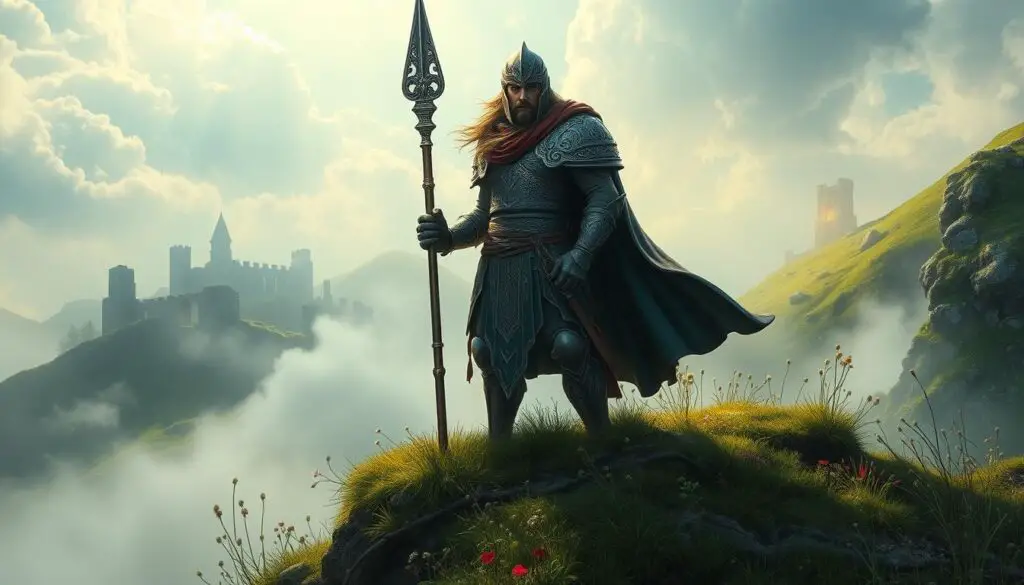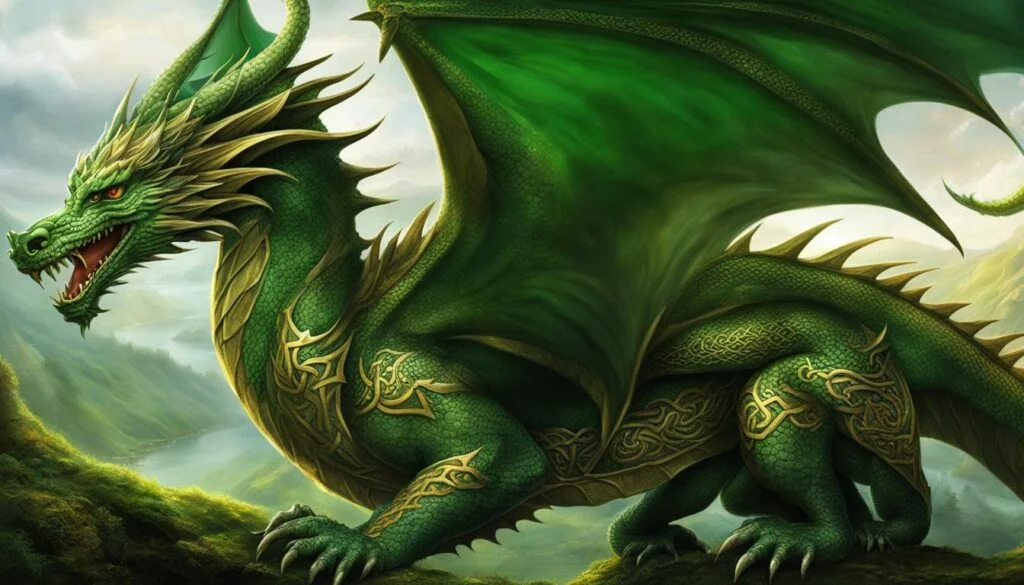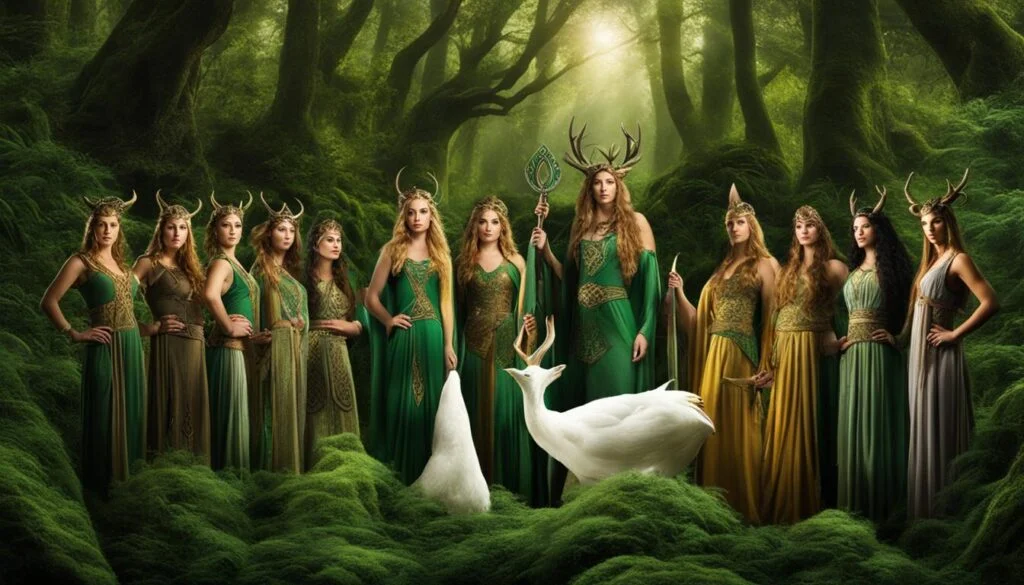Indech was a big name in Celtic mythology. He was part of the Fomorians. These were scary sea raiders.
The Fomorians are famous in ancient Irish stories. They often fought with the Tuatha Dé Danann.
Indech fought as a general. It was in the Second Battle of Mag Tuired.
The goddess Mórrígan made him weaker, choosing the Tuatha Dé Danann’s side. Some stories say Ogma killed him.
Indech’s daughter is important too. She’s in stories with Dagda. They met during Samain.
This shows how their stories are linked.
Key Takeaways
- Indech, a Fomorian general, was a major figure in Celtic mythology.
- The Fomorians are depicted as monstrous sea-raiders in ancient Irish tales.
- Indech’s vitality was drained by the goddess Mórrígan during the Second Battle of Mag Tuired.
- Different myths recount his death at the hands of Ogma.
- Indech’s unnamed daughter is linked to ritual encounters with Dagda during Samain.
The Origins of Indech
Indech is a key figure in Irish myths. He comes from the Fomorians, seen as massive sea-raiders.
These early beings are central to the myths of Ireland before the Christian era.
Indech was Domnu’s son, which made him strong and feared.
Who Were the Fomorians?
The Fomorians were special. They were famous sea-raiders and enemies of the Tuatha Dé Danann.
The latter were known for their connection to nature and smarts.
The Fomorians lived on Tory Island and ruled Ireland first. They were linked to darkness and chaos, unlike the Tuatha Dé Danann’s nature ties.
Their world showed the constant battle in old Irish beliefs.
Indech’s Place in the Fomore Race
Indech was unique among his people. Being Domnu’s child, he was full of his race’s wild spirit.
He symbolized the fight between balance and turmoil. His story is rich with ancient Irish myths. He was a fighter and leader against the Tuatha Dé Danann.
Indech and the Tuatha Dé Danann
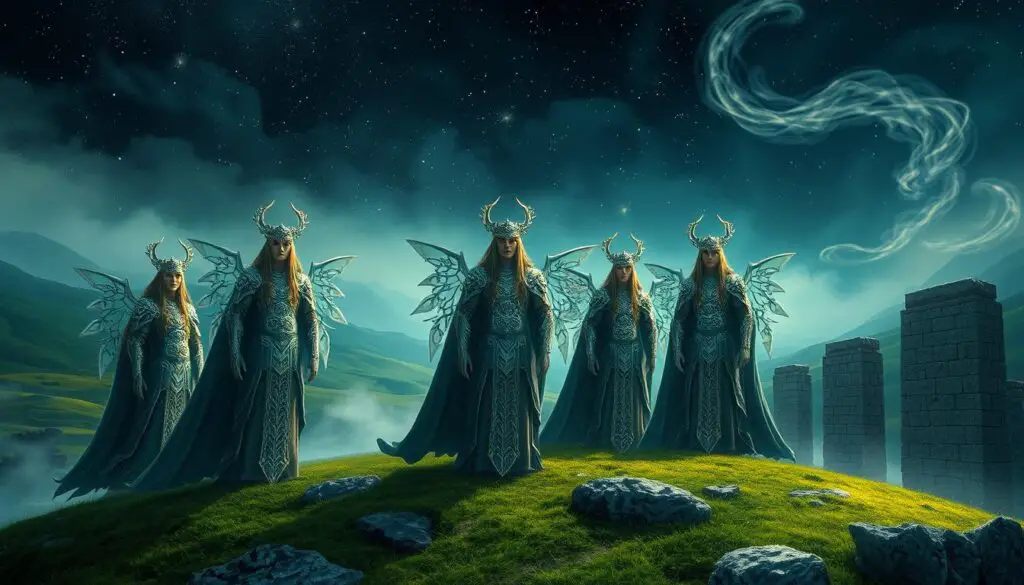
The story of Indech and the Tuatha Dé Danann is rich in Irish legends.
Indech, who led the Fomorians, played a big role.
He battled the Tuatha Dé Danann, showing the drama between these two groups.
The Fomorians, with Indech, were like dark, wild forces.
They fought against the Tuatha Dé Danann who were about light and life. The most famous fight was the Battle of Mag Tuired.
It showed the win of light over darkness in Irish legends.
Many saw the Fomorians as evil spirits from dark places. They often looked scary, with one eye or one arm.
Yet, some like Elatha and Bres were known for their dark beauty. Indech fought against the Tuatha Dé Danann many times.
The Battle of Mag Tuired was crucial in Irish legends. It ended with the Fomorians losing to the Tuatha Dé Danann.
This win meant more than just a battlefield victory. It was about beating a cruel ruler, Bres.
These tales are key in Irish legends and reflect bigger myths of divine wars.
The stories of these two sides show a classic battle of good versus evil. Indech’s story is not only about constant fights.
It makes us think about life, death, and the balance of everything.
Who Was Indech in Celtic Mythology: Key Events
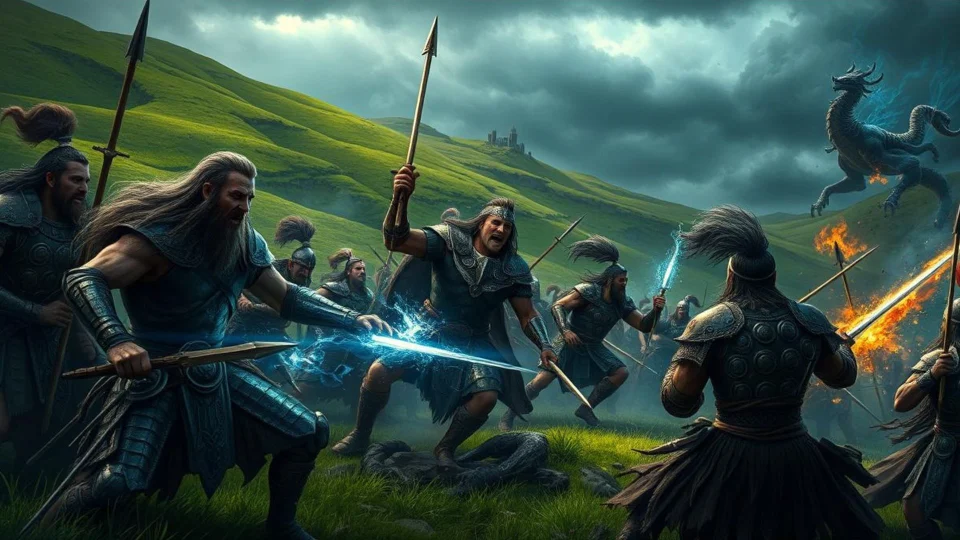
Indech was a big leader of the Fomorians in Celtic stories. He played a huge role in the Second Battle of Mag Tuired.
This battle happened 3000 years ago in what we now call Connaught. It was a fight between the Tuatha Dé Danann and the Fomorians.
The Second Battle of Mag Tuired
The Second Battle of Mag Tuired was a key moment. It showed the Tuatha Dé Danann’s fight against the Fomorians.
The Morrígan, a main goddess in Celtic myth, was very important in this battle.
Before the battle, The Morrígan and the Tuatha Dé Danann leader, Dagda, performed a special ritual.
They wanted to make sure they would win. The Morrígan promised to fight Indech herself.
She planned to make a strong statement to help her friends.
She kept her promise during the fight. This made the Fomorian soldiers very afraid and helped win the battle. Indech’s defeat is tied to The Morrígan, though some stories say Ogma beat him.
Either way, the battle changed Celtic stories a lot. The Morrígan then made two prophecies about peace and the end of the world.
Lady Augusta Gregory’s book, “Gods and Fighting Men,” talks a lot about this battle and Indech.
This book was published in 1904. It uses old stories, smart people’s writings, and more. It’s a key book for understanding Celtic stories and Indech’s place in them.
Indech and The Dagda’s Encounter
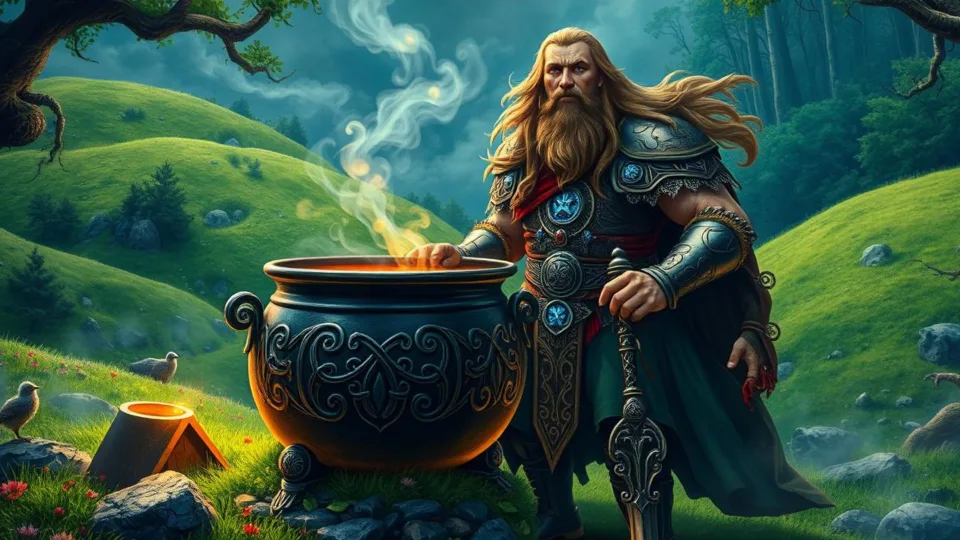
The tales of Indech and the Dagda are rich with wisdom. They teach us about smart thinking and toughness.
One key tale shows the Dagda facing a big test from Indech.
The Challenge of the Broth Cauldron
Indech gave a tough challenge. He had a huge Broth Cauldron ready. It was so big and full, most would walk away.
But the Dagda was not just anyone. Indech asked him to eat all the broth. He hoped this task would push back their battle and test the Dagda’s strength.
Dagda’s Clever Response
The Dagda met the challenge with bravery and smarts. He ate all the broth in the cauldron.
This showed his power and his smart way of handling tough situations. Then he took a nap, showing he was not worried.
This move was smart and cheeky, aiming to put off the fight. This story mixes fun and wisdom, showing why many admire the Dagda in Celtic myths.
Indech’s Family and Relations

Indech was very important in Irish myths. He was a leader in the Formorian group.
His family stories show how deep and complex these myths are.
Indech’s Unnamed Daughter
Indech’s daughter is a key figure. Her story with the Dagda shows deep myth connections.
She linked the Formorians with other myth people. Her story with the Dagda is very important.
Relationship with Other Formorians
Indech had strong ties with other Formorians. These ties were key to their power.
The myths talk a lot about their alliances and fights. His connections show the big picture of myth conflicts.
Indech in Post-Christian Narratives
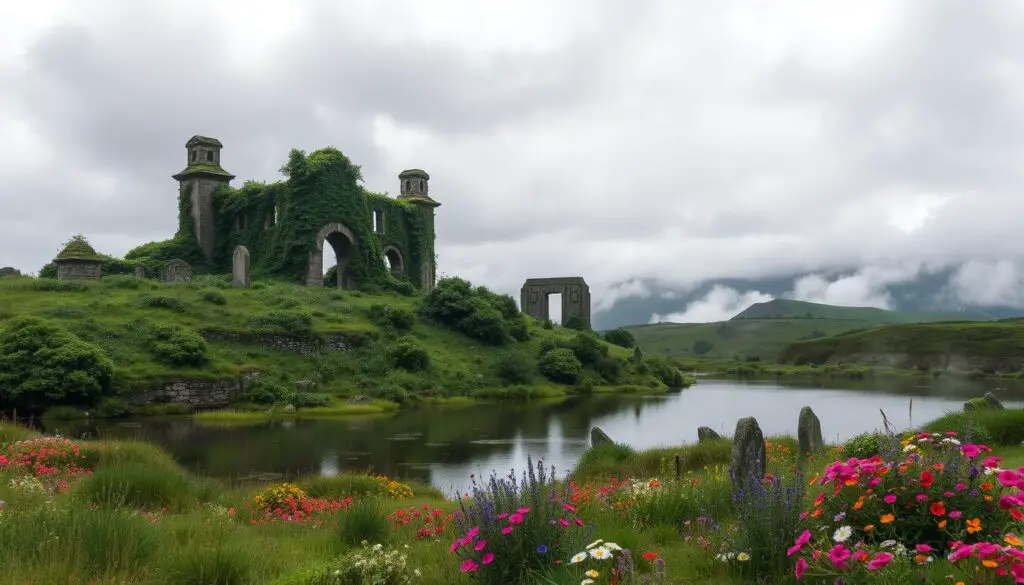
Myths in Post-Christian Ireland changed a lot. This change gave a new meaning to characters like Indech.
When Christianity came, old stories got a new twist. They fit better into this new world. Indech is a great example of this change.
He was a big deal among the Fomorians before.
Indech’s stories changed over time, just like other Celtic myths. This once mighty leader of the Fomorians was seen differently.
He was less of a god and more a symbol of defiance. This shows how myths in Ireland changed after Christianity came.
Take The Morrigan as another example. She is important in Irish myths. Her stories changed too, similar to Indech.
The Morrigan was seen in different ways, including as a maiden, mother, and crone.
Sometimes, she was viewed as a scary woman. Her tales mixed with Christian stories, especially during big events.
Like the time she fought against King Indech and his army.
The changing of myths also brought up folklore tales. Stories about Indech’s fights showed how storytelling evolved.
Gods and goddesses from before became symbols. They represented the fight for cultural identity in Post-Christian Ireland.
The Symbolism of Indech in Irish Mythology
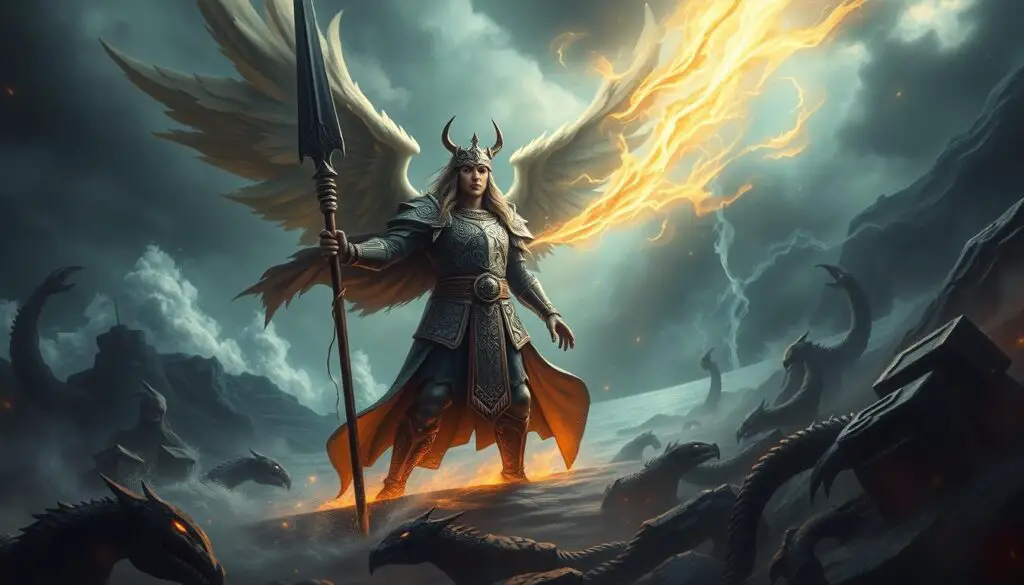
Indech is a key figure in Irish mythology. He symbolizes resistance and conflict.
This is seen in the battles of the Fomorians against others.
Representations of Conflict and Resistance
Indech represents conflict and resistance. His role in epic battles shows ongoing struggles.
These struggles were central in pre-Christian Ireland.
The Second Battle of Mag Tuired shows this well. Indech’s role there highlights the fight against control.
It shows a repeating cycle of power battles.
Indech as a Symbol of Fomorian Power
Indech shows Fomorian strength. He is key in their stories, showing their control.
His roles in battles underline this strength.
Indech’s story also reveals the Fomorians’ complex nature. They are not just foes but have their dynamics.
Through Indech, we see their power and clashes with others.
Pre-Christian Ireland and the Worship of Indech
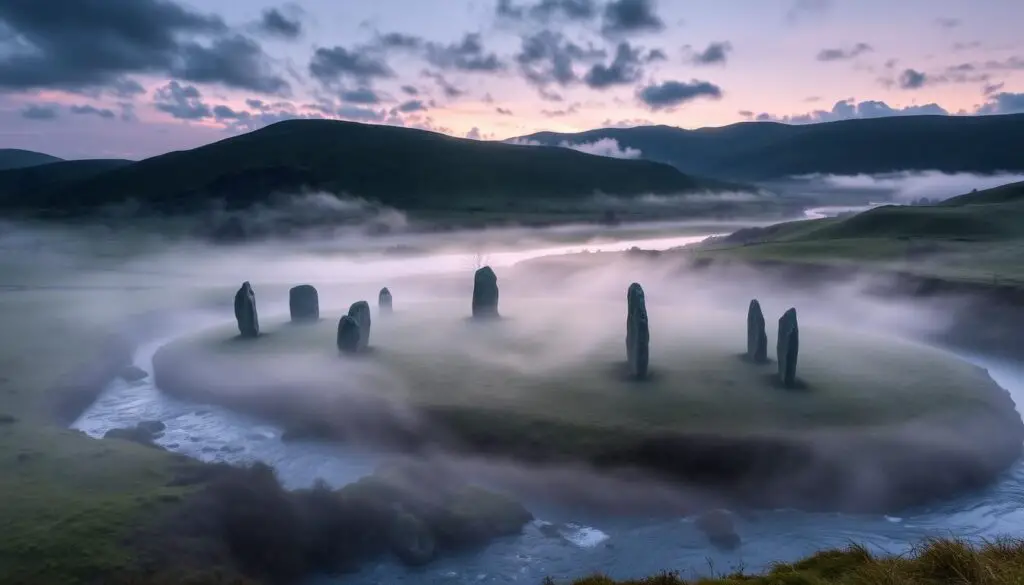
In pre-Christian Ireland, many people followed ancient Celtic customs.
They held stories and figures like Indech in high regard. J.A. MacCulloch talks about this in his book, The Religion of the Ancient Celts, from 1911.
He says that learning about Celtic religion began not too long ago.
He refers to the “Metrical Dindshenchas” and “Lebor Gabála Érenn”. These books are key to the Mythological Cycle.
They tell us about the Tuatha Dé Danann and their fights with the Fomorians.
These stories help us see how Indech was seen in pre-Christian Ireland.
The Celts had many kinds of worship. They respected nature, wells, plants, and animals.
They believed in the cult of the dead and practiced rites of sacrifice and prayer.
Indech was likely a big part of their religious life.
This shows their deep bond with nature and its spirits.
Celtic mythology names over 300 gods, many of whom were local guardians.
This shows how important these figures were every day. It’s crucial to know how these beliefs changed with the coming of Christianity.
The Legacy of Indech in Gaelic Folklore

Indech’s story has lived on for centuries, touching the hearts of many people today.
He often appears as a strong figure in myths, showing big themes. His tales are complex but full of meaning, making them memorable.
Modern Interpretations
The story of Indech gets a modern twist nowadays. New stories keep his spirit but add fresh details for us today.
His fights, especially with the Dagda, inspire tales of struggle and power now.
Indech in Literature and Popular Culture
Indech jumps from old stories to today’s books and shows. Writers and creators link him to current issues or use his story to add mystery.
His tale keeps getting shared, keeping Indech important in our stories.
Fiction often goes back to his famous battles, mixing old stories with new ideas.
This makes the old myths interesting and understandable to everyone today.
Indech’s story mixes the old with the new beautifully. This shows how stories from long ago can still mean a lot to us.
Conclusion
Indech’s story helps us understand ancient Irish culture, beliefs, and storytelling.
He was important among the Fomorians. His battles, like the Second Battle of Mag Tuired, show Irish legends’ depth.
Here, 100,000 Fir Bolg were defeated, showing the myth’s scale.
Indech represents power, resistance, and cultural identity in these myths. His alliances and fights reveal the legends’ complex dynamics.
The stories also highlight the Tuatha Dé Danann’s magical knowledge, adding mysticism to their heroism.
In summary, Indech’s story fascinates scholars and fans alike. His role in ancient battles and modern stories shows the lasting charm of Irish legends.
This rich heritage continues to shed light on Ireland’s culture and myths.
Frequently Asked Questions
Q: What was Indech’s place in the Fomorian race?
Indech was a king of the Fomorians, a supernatural race often depicted as hostile and monstrous beings in Irish mythology. He is known for his opposition to the Tuatha Dé Danann during the Second Battle of Mag Tuired.
Q: What happened during the Second Battle of Mag Tuired?
The Second Battle of Mag Tuired was a legendary confrontation in Irish mythology between the Tuatha Dé Danann and the Fomorians. Indech played a crucial role in this battle, which ended in the defeat of the Fomorians and established the dominion of the Tuatha Dé Danann over Ireland.
Q: What were the Tuatha Dé Danann?
The Tuatha Dé Danann are one of the mythological races in Irish folklore, depicted as god-like beings with skills in magic and craftsmanship. They are celebrated as divine ancestors and were considered the preeminent supernatural beings in Ireland before being supplanted by human settlers.
Q: What was the challenge of the broth cauldron set by Indech?
In the myths, Indech issued a challenge involving a broth cauldron, a test of courage or strength, to the leaders of the Tuatha Dé Danann during the Second Battle of Mag Tuired, though specific details of the challenge vary across different texts.
Q: Who was Indech’s unnamed daughter?
Indech’s daughter, although unnamed in some accounts, is sometimes identified as one who played a role in the myths surrounding the Second Battle of Mag Tuired, including interactions with prominent figures of the Tuatha Dé Danann, like Lug.
Q: What does Indech symbolize in Irish mythology?
Indech symbolizes the chaos and destructive force of nature as a leader of the Fomorians, often representing the antagonistic forces that the Tuatha Dé Danann had to overcome to establish their authority and bring order to Ireland.


